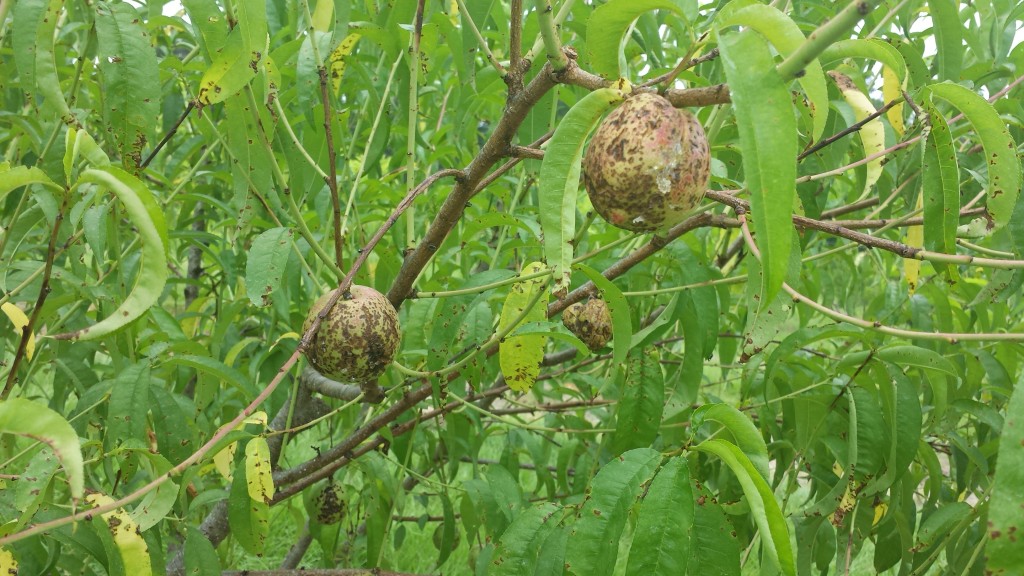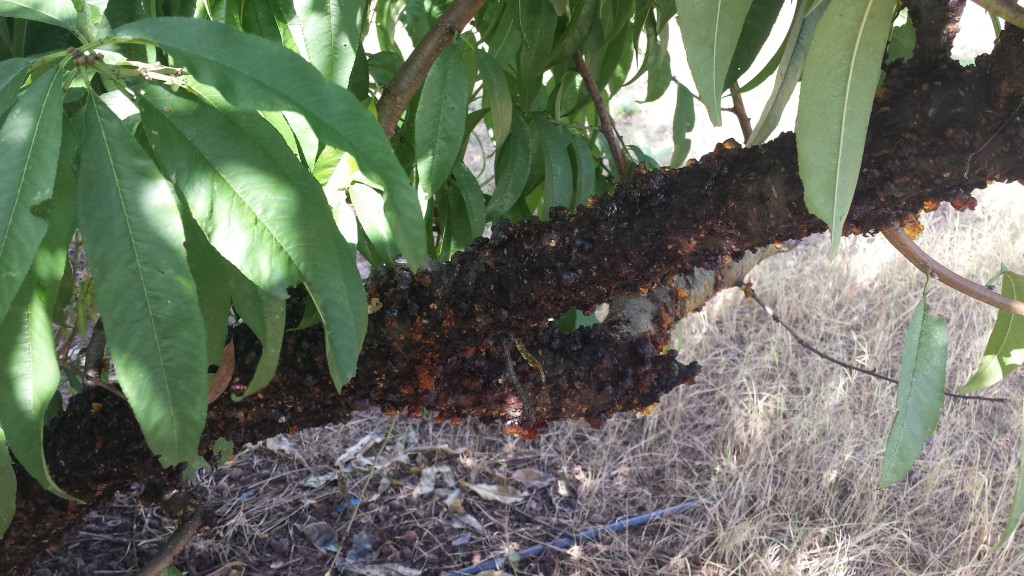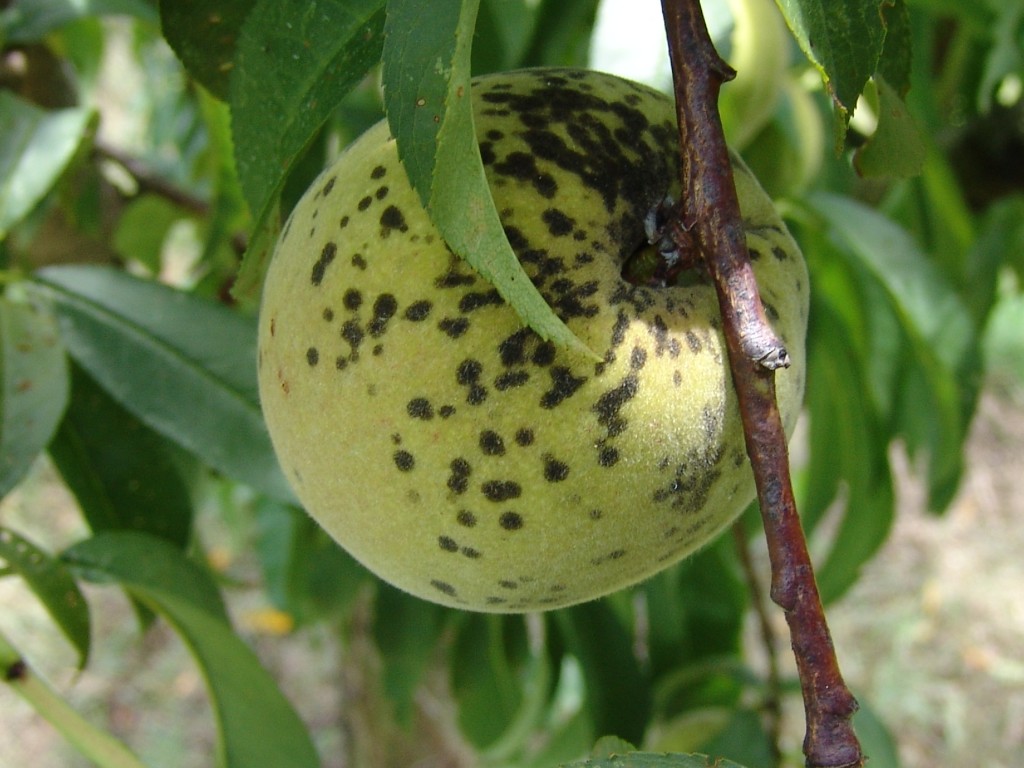Diseases
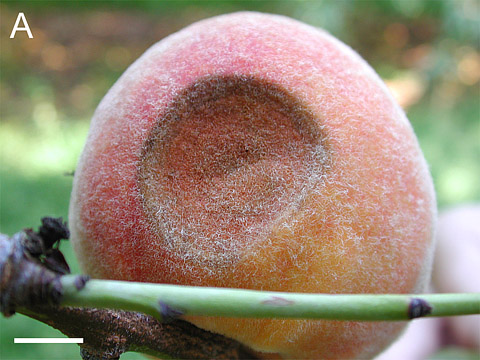
Common Name: Anthracnose, Crater Rot
Scientific name: Colletotrichum gloeosporioides or Colletrotrichum acutatum
The first symptom of anthracnose is a small yellowish spot on the fruit surface. This spot gradually grows and becomes a circular, sunken or tan lesion on the surface of the fruit. The decay continues, and in the affected part fruit flesh changes to a grayish black color.
Image from Plant Health Progress article: Identifying and Characterizing Summer Diseases on ‘Babygold’ Peach in South Carolina

Common Name: Armillaria Root Rot
Scientific name: Armillaria
Armillaria Root Rot is a soil borne fungal disease. Armillaria Root Rot attacks the root system and crown tissue of plants. The first obvious symptoms are wilting, bronzing and later chlorosis of foliage. This is followed by foliar collapse/abscission and ultimately tree death. Upon investigation one will find a well-developed mycelial mat beneath the root bark (rarely extending much above the soil line on the trunk). Later clusters of gill type mushrooms will appear at the base of dead and dying trees.
Image from Dr. Tom Beckman USDA-ARS.
Common Name: Bacterial Spot
Scientific name: Xanthomonas arboricola or X. campestris.
This disease may affect foliage, twigs, and fruit. The first symptom is soaked spots on the leaves. This spot may grow darker and become necrotic. Affected leaves turn yellow. Spots also appear on the fruit, causing damage and allowing entrance for other pathogens. To properly identify this pathogen, look for angular lesions on the leaves and fruit.
Image from Dr. Dario Chavez. University of Georgia. Peach Specialist.
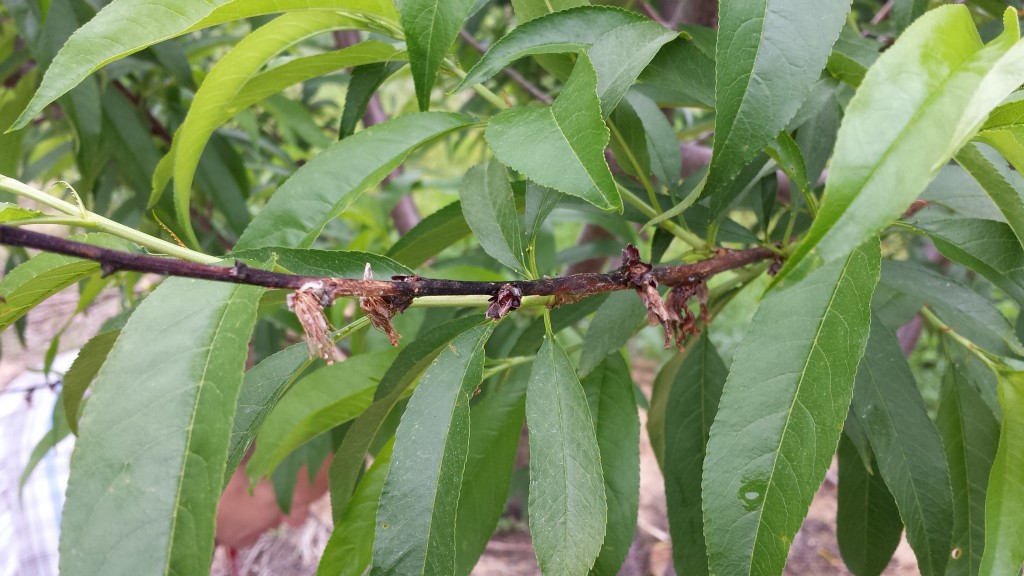
Common Name: Blossom Blight
Scientific name: Monilinia fructicola
Blossom Blight appears when trees begin to bloom and causes blossoms to change from their natural color to a tan or brown color. The blossoms then droop as if they had frost damage. Once the disease starts, it develops quickly and will spread to the twigs, branches, leaves, and fruit. Affected wood may become gummy.
Image from Dr. Dario Chavez. University of Georgia. Peach Specialist.
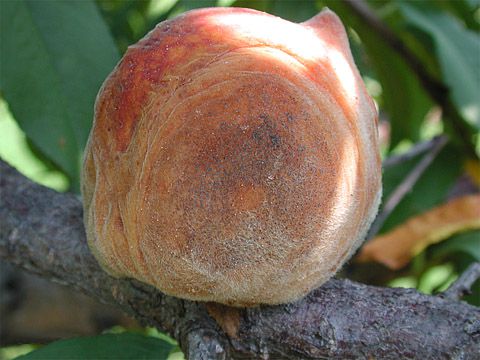
Common Name: Botryosphaeria Fruit Rot
Scientific name: Botryosphaeria dothidea
This disease affects the fruit causing circular lesions. This pathogen can be easily confused with anthracnose. However, Botryoshaeria produces softer lesions.
Image from Plant Health Progress article: Identifying and Characterizing Summer Diseases on ‘Babygold’ Peach in South Carolina
Common Name: Brown Rot
Scientific name: Monilinia fructicola
Symptoms of brown rot may include blossom and twig blight, cankers, and fruit rot. Shoots infected become sunken and brown. Ripened fruits that become infected develop tan to gray round spots. These spots rot the fruit and grow larger until the entire fruit is infected. The fruit then falls off the tree, or becomes a mummy.
Image from Dr. Phil Brannen. University of Georgia. Plant pathology.
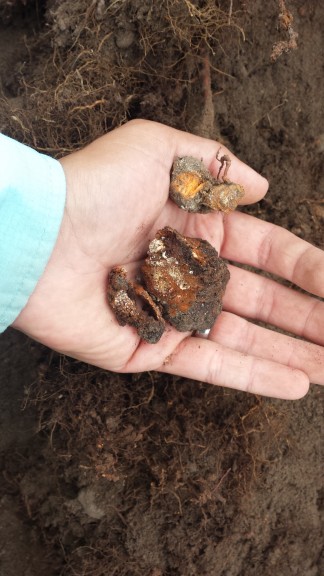 |
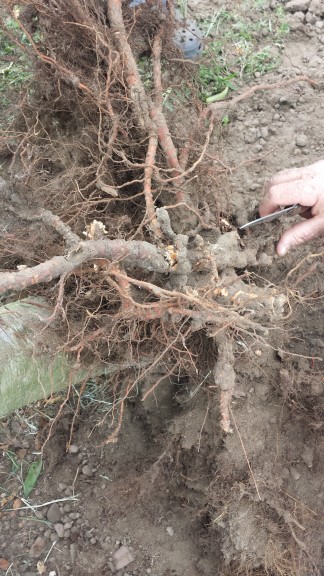 |
Common Name: Crown Gall
Scientific name: Agrobacterium tumefaciens
Crown Gall shows up as abnormal tumors or galls on the roots, or trunk of the tree. New galls are light in color and usually have a soft, spongy texture. The galls become hard and darker with age. Crown gall affects water and nutrient transportation. Therefore, trees affected by crown gall often develop nutrient deficiencies.
Image from Dr. Dario Chavez. University of Georgia. Peach Specialist.
Common Name: Gummosis
Scientific name: Botryosphaeria dothidea
Small blisters on the bark of young trees is an early sign of the disease. Over time, the lesions in these blisters release resin and become sunken into the bark of the tree, forming cankers.
Image from Dr. Dario Chavez. University of Georgia. Peach Specialist.
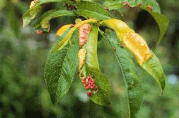
Common Name: Peach Leaf Curl
Scientific name: Taphrina deformans
Outbreaks may occur during spring when the weather is cool and moist. Infected leaves become thick, curly, and distorted. In severe cases, defoliation occurs and fruit yield may be affected.
Image from Clemson Cooperative Extension website.

Common Name: Peach Leaf Rust
Scientific name: Tranzschelia
Infections can appear on twigs, leaves, and fruit, but symptoms do not show up until early fall. One of the first symptoms is the developing of twig cankers, which are small blisters and longitudinal splits in the bark. Next, leaf lesions start to appear as bright yellow spots on the surface of the leaves. If you look closely you may even be able to see brown spore masses on the leaves. Finally, lesions start to appear on the fruit as brown spots with green or greenish yellow halos. These symptoms can be confused with stinkbug damage. To be sure you are dealing with peach leaf rust, look for previous symptoms as well.
Image from Dr. Phil Brannen, UGA. Clemson Cooperative Extension website.
Common Name: Peach Scab
Scientific name: Cladosporium carpophilum
Scab damages the fruit appearance and can cause cracking in the peach skin. This cracking allows for other pathogens to enter the fruit and cause additional damage. Peach Scab is easy to identify by the “scabs” or spots of greenish to black color that appear on the surface of the fruit, twigs, shoots and leaves.
Image from Dr. Phil Brannen. University of Georgia. Plant pathology.
Common Name: Peach Tree Short Life (PTSL)
Scientific name: Pseudomonas spp.
Symptoms of peach tree short life include the sudden wilting and collapse of emerging shoots and flowers during early spring development. Others symptoms include internal browning and necrosis (bacterial canker or freeze damage) beneath the bark of scaffold limbs and trunk usually accompanied by a strong sour sap odor and trunk leakage. Severe damage will result in the complete collapse and death of the above ground portion of the tree. Later the still living root system will often send up numerous suckers.
Image from Dr. Tom Beckman. USDA-ARS.

Common Name: Phony Peach
Scientific name: Xylella fastidiosa
Symptoms of this disease are not visible until after 18 months of infection. The new growth is heavily reduced, giving the trees a stunted look. Bloom and fruit ripening happens earlier than usual, causing fruit size reduction. Infected bark displays black discoloration. The disease is vectored by leafhoppers.
Image from Clemson Cooperative Extension website.
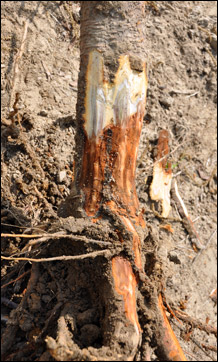
Common Name: Phytophthora Crown & Root Rot
Scientific name: Phytophora spp.
Phytophthora can be found in trees planted on poorly drained soils. This disease reduces tree growth vigor and causes chlorosis in the leaves. Foliage often becomes reddish or purple, and eventually the pathogen can kill the tree.
Image from Clemson Cooperative Extension website.

Common Name: Powdery Mildew
Scientific name: Sphaerotheca pannosa and Podosphaera leucotricha
Powdery mildew can infect both the leaves and the fruit of a peach tree. When peach leaves are infected, they become shapeless and wrinkled. Diseased fruit develop a white powder on the fruit surface as seen in the picture below.
Image from Clemson Cooperative Extension website.
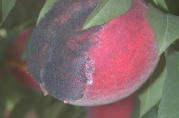
Common Name: Rhizopus Rot
Scientific name: Phytophora spp.
This rot is one of the biggest issues in post harvest fruit handling, causing major financial losses. To identify this disease, look for the following symptoms on ripened fruit: dark grey fuzz on the surface of the peach.
Image from Clemson Cooperative Extension website.


